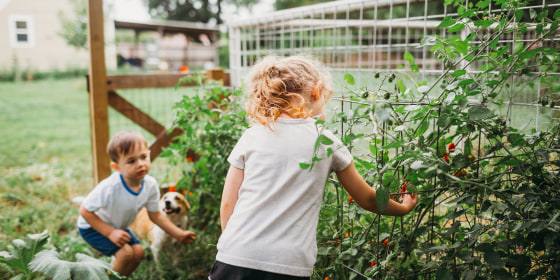

It can be hard to know how to start your backyard garden — how to tend to the fruits, vegetables, herbs and more. Beyond gloves or tools like trowels and shovels, one of the gardening gadgets you’re likely to come across in neighborhood nurseries or the landscaping section of a home improvement store is a plant cage. For a home gardener, a plant cage is designed “to support and protect plants as they grow,” said gardening consultant Pol Bishop, who works with Fantastic Gardeners, a gardening and landscaping maintenance service based in England.
As such, plant cages could be something to consider for your backyard, whether you’re a first-timer or a seasoned grower. Getting a green thumb grew in popularity over the past year. What started off as planting out of panic has, however, blossomed into an actual hobby for some — with what seemed like a seed shortage happening earlier this year. That’s on top of the rise of plant parenthood (especially houseplants) that’s taken root over more recent years. To help your shopping, we consulted experts about picking the best plant cages and compiled some significant plant cages based on their recommendations.
For starters, the name plant cage is a slight misnomer — it isn’t like a little greenhouse. Instead, you can think of a plant cage as a sort of fence surrounding a plant, “supporting and guiding the plant to grow vertically instead of on the ground,” said Ryan Smith, owner of Ant & Garden Organic Pest Control in Beaverton, Oregon. Plant cages are a kind of support structure (more on that below), albeit much smaller in size than trellises, ladders and arches that you’ll see when shopping for gardening essentials, Bishop told us.
At its core, a cage is supposed to “support plants that are unable to support themselves,” explained Cory Tanner, the horticulture program team director at Clemson University. “The plants supported by cages are generally those that are trailing or semi-vining, but not able to support themselves on a vertical structure like a trellis or arbor (such as tomato plants), or those with fragile stems that cannot support a heavy fruit load (such as some pepper plants).”
A plant cage is meant to go around the perimeter of a plant, holding it up from the outside, explained blogger Erinn Witz of Seeds and Spades. “Traditional cages typically have three or four vertical rods and three or more horizontal rings. The vertical rods provide the basic shape and the horizontal rings offer a place for stems and branches to rest.” The lower parts of these rods also double as stakes, which can go several inches into the ground usually, Witz added. Here are what Witz calls its “goals”:
Cages tend to come in three shapes — round, square and triangular — and some feature open-weave tops for flowering stems to grow through and to help bushy plants like peonies get a more natural shape, Witz said. You might see semi-circular frames such as this one advertised as plant cages, but consider them more of a plant support (for smaller flowers) than an actual cage.
Experts didn’t endorse one shape of plant cage over others — as mentioned above, cages can be round, rectangular or triangular. Focus on the material one is made out of.
Witz prefers steel cages because of their lightness, availability and affordability, along with their tendency to “have a little bit of give,” too. She believes the powder-coated cages are best since they’re rust-resistant — green can “blend right into your garden.” Smith similarly favors steel since it’s “heavy duty and can support heavy crops.”
Wire and wood are also common when it comes to plant cages, Tanner told us. He didn’t recommend one over the other but mentioned that wire is normally less expensive and can last many seasons if not bent excessively while wood has a “shorter lifespan.”
Bishop advised against a plastic plant cage. “Don't buy anything made of plastic. Apart from not being environmentally-friendly, plastic is prone to weathering faster compared to other materials. It can be damaged by the sun and cold and break quicker compared to structures made of wood or metal.”
We asked experts about the best plant cages for your garden — and found other options based on their guidance, as well.
This cage is a personal favorite of Smith who mentioned it was “ideal for those with minimal garden space.” “It’s made of stainless steel and I love that it’s adjustable. This way, I can support my plants as they grow.” The cage is available in two sizes, 32.7 inches and 48.4 inches tall. While it’s branded as a tomato cage, it’s also designed to help grow pole beans, cucumbers, grapes and kiwi.
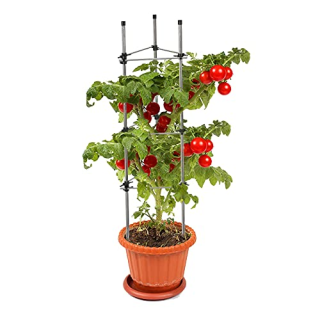
Featuring a steel core with a plastic coating that’s rust-resistant, this cage is designed for both indoor and outdoor plants. The cage comes with snap-on clips to reposition the stakes — you can adjust them up to 72 inches or as low as 16 inches in height. As Witz mentioned above, the green shade can help the cage blend in in your garden. It’s a popular pick with Amazon shoppers, earning an average 4.4-star rating over more than 480 reviews.
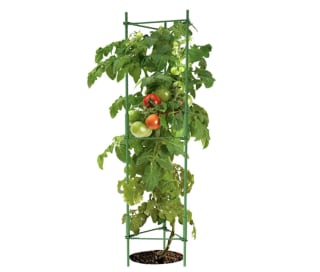
While Witz recommended a plant cage from Gardener’s Blue Ribbon, it’s only available for in-store pick-up. This top-rated cage from Amazon is similar in shape and is made from galvanized wire. It reaches 33 inches in height for smaller vegetables and flowers. Since it comes in a pack of 10, the cage might be more useful for those with bigger gardens. These cages have earned an average 4.1-star rating over more than 1,193 reviews.
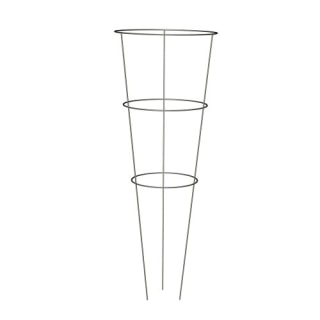
These powder-coated steel cages are designed to support plants on all sides without the need for tying them up. Each cage also features 8-inch square openings to help with harvesting. Once the season is over, the hinged panels can be folded flat, according to the brand. You can also find a taller version of these cages, which come in a set of two, on Amazon.
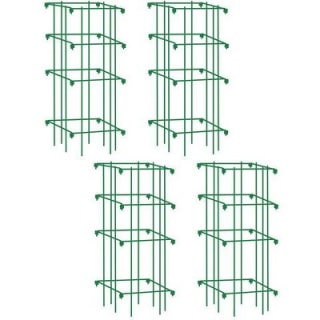
For home gardeners with plans for more plants in their gardens, this pack of three garden cages could be helpful. The cages can be assembled with the included stakes made from steel with a plastic coating and snap-on arms to secure the stakes, along with clips and twist ties to attach to other trellises in your garden. You can adjust the stakes to reach a maximum height of 51 inches. It boasts an average 4.2-star rating over more than 800 reviews.
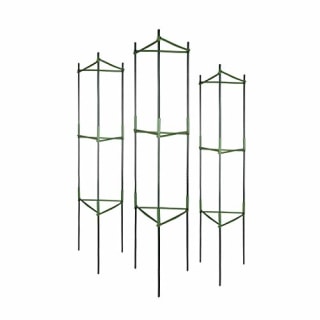
If you’re searching for a couple of cages, consider this pack of five. It’s available in two sizes, 14 inches by 42 inches or 16 inches by 54 inches. Each is designed to offer heavy duty support, made from a galvanized steel wire that’s been painted with a powder coating. It’s also meant for plants and vines that are 10 pounds in size. The cages currently come in four colors: Emerald Green, Green, Light Green and Red.
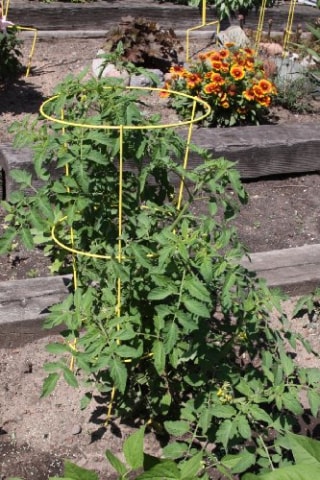
Plant cages are a particular type of support structure that may or may not be right for your garden, depending on what you’re growing. “Besides providing support, plant cages can be used as focal points in garden design,” Bishop said. “Depending on the style of your garden, you can pick a different support structure and incorporate it in your landscape. Bigger structures can also play a double role and provide shade or separate the garden in different sections.
The following are a few of the most common garden support structures you’ll see and what they’re intended to do, according to Bishop.
When searching for a plant cage, you’ll often see them marketed mainly towards tomatoes. That’s because gardeners usually use them for plants that produce heavy fruits (yes, technically, a tomato is a fruit), Witz said. But other plants can also benefit from some support. The following are among the most common plants a cage could be used with, according to the experts that we talked to.
As for what plants don’t need a plant cage, heaving vining plants like melons and squash will be too big (you can leave them on a large trellis or on the ground) while peppers, bush beans and leafy greens don’t need any additional support at all, according to Witz.
You should use a cage when plants in your garden are young or when you first start planting seeds, experts explained. “My best tip is to go ahead and place your cage even if you think you don’t need to yet,” Witz said. “Plants sometimes grow faster than you anticipate, and attempting to fit a cage around a larger plant can be difficult or impossible. This is definitely a case of better safe than sorry”
Otherwise, installing a plant cage is fairly straightforward, according to experts.
“Plant cages are used to conserve space, so if you have minimal space for your garden, you should definitely try installing them,” Smith mentioned. Tanner agreed: “Growing the plants vertically uses much less square footage than allowing them to sprawl on the ground.”
By now, you’ve probably heard — literally — about the billions of cicadas emerging from the ground after almost two decades away (they’re partaking in a month-long mating ritual). While these cicadas are pesky, they aren’t pests — in fact, the three experts we spoke to said that they’re more of an annoyance than an actual danger.
“These periodical cicadas do not pose a risk to humans or pets. They are only interested in singing (to attract mates), mating and laying eggs,” explained J.C. Chong, a professor and entomology extension specialist at Clemson University. “Once all females have laid eggs, they all die. Their loud songs may be an annoyance for some, but it’s a great conversation starter for others.” If you’re wondering where all the noise comes from, it’s because male cicadas sing and female cicadas respond to these songs by making a clicking sound with their wings, mentioned Kathy Glassey, director of renewable services at Monster Tree Service.
For home gardeners, these cicadas aren’t really a cause for concern — they don’t eat away garden vegetables but they sometimes lay eggs in the branches of young saplings (trees) and small scrubs, explained University of Maryland entomologist Michael J. Raupp. Raupp suggested wrapping young trees in cicada netting but said it’s “already too late to do this in much of the range where cicadas are emerging.” If you’re noticing cicadas throughout your backyard, Chong recommended reveling in the “spectacle.” “No management is needed at all for the typical dog-day cicadas.”
Plant cages aren’t meant to protect crops from insects, either. “Plant cages can help protect plants from certain animals like deer, cats, dogs and some birds. However, you can’t avoid insects with plant cages,” Bishop said. “There are other structures like plant tents and netting that can protect from insects and pests, but they don’t offer support for plants to grow.” Likewise, a plant cloche, which is generally made from glass and shaped like a bell, is meant to provide protection against pests, birds and frost, according to Smith. You can DIY one using old plastic bottles, he added.